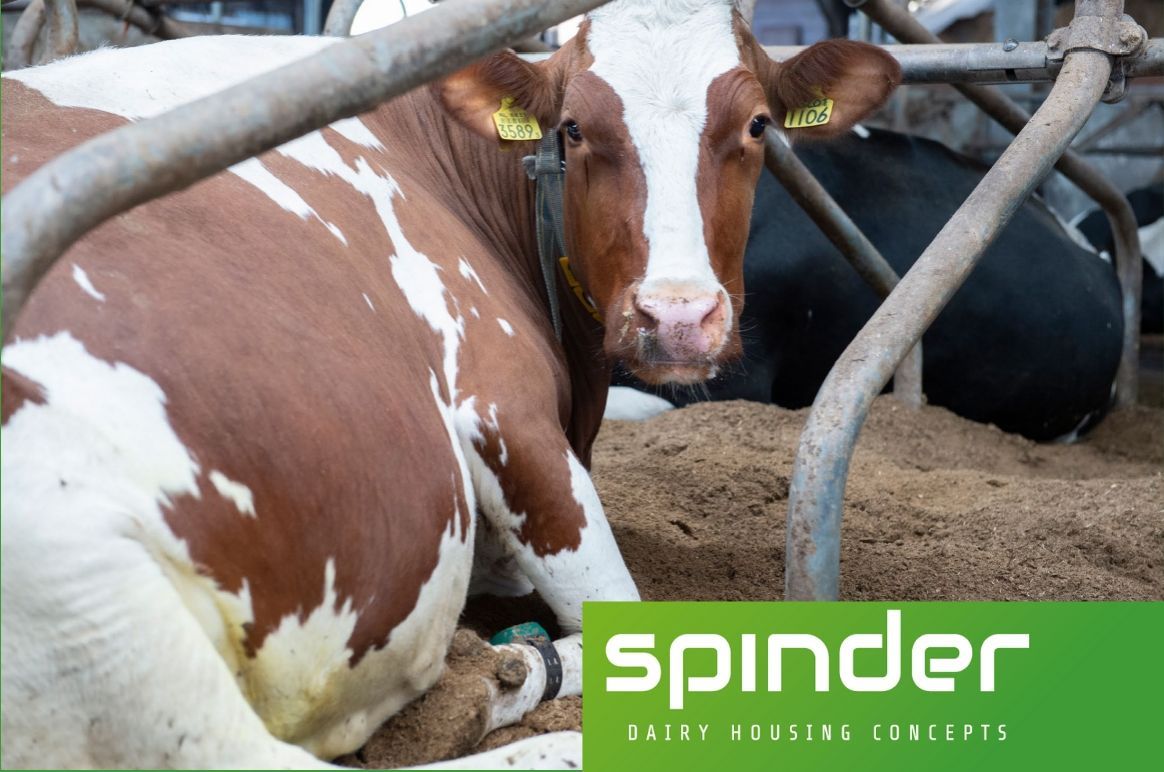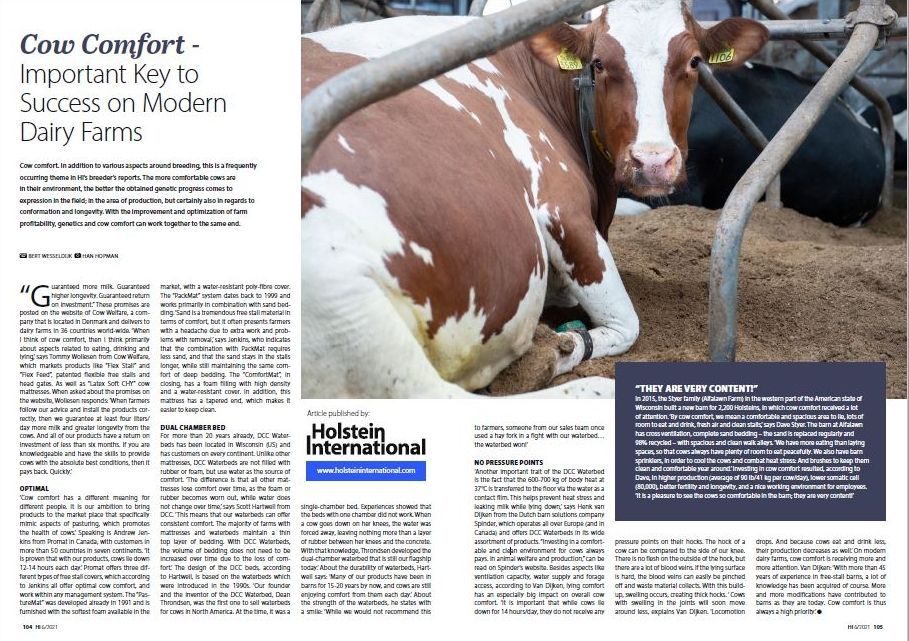Cow Comfort - Important Key to Success on Modern Dairy Farms
Cow comfort. In addition to various aspects around breeding, this is a frequently occurring theme in HI’s breeder’s reports. The more comfortable cows are in their environment, the better the obtained genetic progress comes to expression in the field; in the area of production, but certainly also in regards to conformation and longevity. With the improvement and optimization of farm profitability, genetics and cow comfort can work together to the same end.(Text: Bert Wesseldijk photographer: Han Hopman)
“Guaranteed more milk. Guaranteed higher longevity. Guaranteed return on investment.” These promises are posted on the website of Cow Welfare, a company that is located in Denmark and delivers to dairy farms in 36 countries world-wide. ‘When I think of cow comfort, then I think primarily about aspects related to eating, drinking and lying,’ says Tommy Wollesen from Cow Welfare, which markets products like “Flex Stall” and “Flex Feed”, patented flexible free stalls and head gates. As well as “Latex Soft CHY” cow mattresses. When asked about the promises on the website, Wollesen responds: ‘When farmers follow our advice and install the products correctly, then we guarantee at least four liters/ day more milk and greater longevity from the cows. And all of our products have a return on investment of less than six months. If you are knowledgeable and have the skills to provide cows with the absolute best conditions, then it pays back. Quickly.’

Optimal
‘Cow comfort has a different meaning for different people. It is our ambition to bring products to the market place that specifically mimic aspects of pasturing, which promotes the health of cows.’ Speaking is Andrew Jenkins from Promat in Canada, with customers in more than 50 countries in seven continents. ‘It is proven that with our products, cows lie down 12-14 hours each day.’ Promat offers three different types of free stall covers, which according to Jenkins all offer optimal cow comfort, and work within any management system. The “Pasture Mat” was developed already in 1991 and is furnished with the softest foam available in the market, with a water-resistant poly-fibre cover. The “Pack Mat” system dates back to 1999 and works primarily in combination with sand bedding. ‘Sand is a tremendous free stall material in terms of comfort, but it often presents farmers with a headache due to extra work and problems with removal,’ says Jenkins, who indicates that the combination with PackMat requires less sand, and that the sand stays in the stalls longer, while still maintaining the same comfort of deep bedding. The “Comfort Mat”, in closing, has a foam filling with high density and a water-resistant cover. In addition, this mattress has a tapered end, which makes it easier to keep clean.
“They are very content!”
In 2015, the Styer family (Alfalawn Farm) in the western part of the American state of Wisconsin built a new barn for 2,200 Holsteins, in which cow comfort received a lot of attention. ‘By cow comfort, we mean a comfortable and spacious area to lie, lots of room to eat and drink, fresh air and clean stalls,’ says Dave Styer. The barn at Alfalawn has cross ventilation, complete sand bedding – the sand is replaced regularly and 98% recycled – with spacious and clean walk alleys. ‘We have more eating than laying spaces, so that cows always have plenty of room to eat peacefully. We also have barn sprinklers, in order to cool the cows and combat heat stress: And brushes to keep them clean and comfortable year around.’ Investing in cow comfort resulted, according to Dave, in higher production (average of 90 lb/41 kg per cow/day), lower somatic cell (80,000), better fertility and longevity, and a nice working environment for employees. ‘It is a pleasure to see the cows so comfortable in the barn; they are very content!’
Dual Chamber Bed
For more than 20 years already, DCC Waterbeds has been located in Wisconsin (US) and has customers on every continent. Unlike other mattresses, DCC Waterbeds are not filled with rubber or foam, but use water as the source of comfort. ‘The difference is that all other mattresses lose comfort over time, as the foam or rubber becomes worn out, while water does not change over time,’ says Scott Hartwell from DCC. ‘This means that our waterbeds can offer consistent comfort. The majority of farms with mattresses and waterbeds maintain a thin top layer of bedding. With DCC Waterbeds, the volume of bedding does not need to be increased over time due to the loss of comfort.’ The design of the DCC beds, according to Hartwell, is based on the waterbeds which were introduced in the 1990s. ‘Our founder and the inventor of the DCC Waterbed, Dean Throndsen, was the first one to sell waterbeds for cows in North America. At the time, it was a single-chamber bed. Experiences showed that the beds with one chamber did not work. When a cow goes down on her knees, the water was forced away, leaving nothing more than a layer of rubber between her knees and the concrete. With that knowledge, Throndsen developed the dual-chamber waterbed that is still our flagship today.’ About the durability of waterbeds, Hartwell says: ‘Many of our products have been in barns for 15-20 years by now, and cows are still enjoying comfort from them each day.’ About the strength of the waterbeds, he states with a smile: ‘While we would not recommend this to farmers, someone from our sales team once used a hay fork in a fight with our waterbed… the waterbed won!’
No pressure points
‘Another important trait of the DCC Waterbed is the fact that the 600-700 kg of body heat at 37°C is transferred to the floor via the water as a contact film. This helps prevent heat stress and leaking milk while lying down,’ says Henk van Dijken from the Dutch barn solutions company Spinder, which operates all over Europe (and in Canada) and offers DCC Waterbeds in its wide assortment of products. “Investing in a comfortable and clean environment for cows always pays. In animal welfare and production,” can be read on Spinder’s website. Besides aspects like ventilation capacity, water supply and forage access, according to Van Dijken, lying comfort has an especially big impact on overall cow comfort. ‘It is important that while cows lie down for 14 hours/day, they do not receive any pressure points on their hocks. The hock of a cow can be compared to the side of our knee. There is no flesh on the outside of the hock, but there are a lot of blood veins. If the lying surface is hard, the blood veins can easily be pinched off and waste material collects. With this buildup, swelling occurs, creating thick hocks. ’ Cows with swelling in the joints will soon move around less, explains Van Dijken. ‘Locomotion drops. And because cows eat and drink less, their production decreases as well.’ On modern dairy farms, cow comfort is receiving more and more attention. Van Dijken: ‘With more than 45 years of experience in free-stall barns, a lot of knowledge has been acquired of course. More and more modifications have contributed to
barns as they are today. Cow comfort is thus always a high priority.’
Article published by: Holstein International
Click here for the original article
